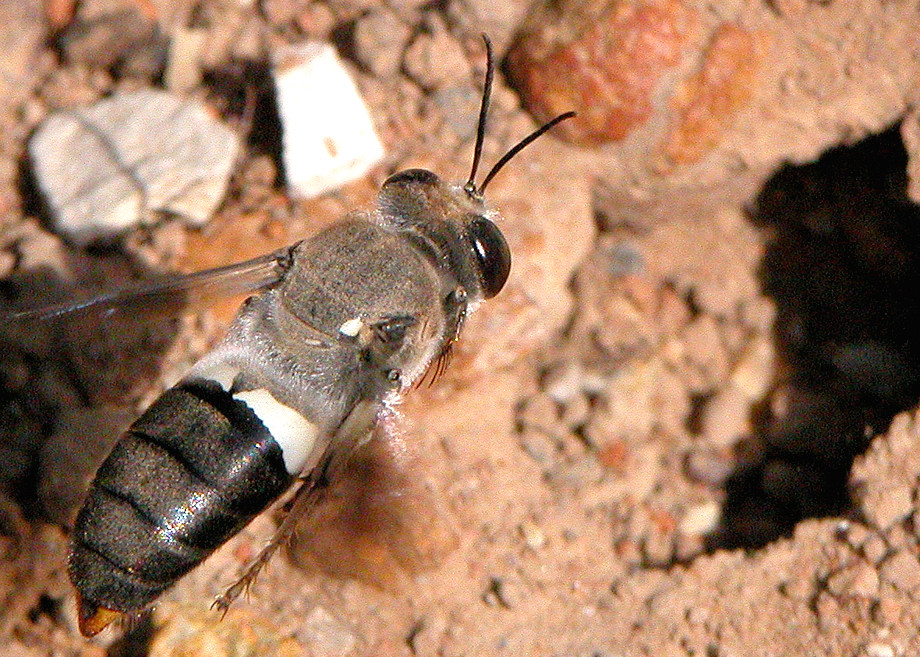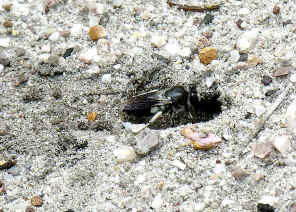|
| |
Family Crabronidae
- This page contains pictures and information about Panda Sand Wasps that we
found in the Brisbane area, Queensland, Australia.
-
 - Body length 20mm
-
- We call them Panda Sand Wasps because they are black and white in colour.
-
First we thought it is the Colletid Bee
 
 - Bembix sp., body length 20mm
-
- We took those pictures in Karawatha Forest in mid summer. There was a small
sand dam to stop the rain washing the dirt to the footpath. There were quite a
number of wasps digging hole there. They flying back and forwards, chasing
each other, digging holes and walking in and out of the holes. They favour the
small dam could be because the sand were loose there.
-


 -
- Their body is brown in colour. On their abdomen there is the white pattern
which makes their waist look narrow. Although they have a waist but which is
not narrow as most of other wasps or bees.
-
- When we first found this wasp in 2005, we thought it was the Colletid Bee which also
burrow nest in ground. On summer 2007, we found that they feed their young
with flies (Diptera), so definitely
they are not bees (all bees feed their young with pollen). Then we check that
they could be Sand wasp. Only Sand Wasp genus Bembix feed their young
with flies.
-
They build nest in sandy soil
 
 -
- The pictures show the sand patch on Karawatha Forest Bushtail Track. The
were about 5 to 6 nests found in the sand patch.
-
 
 - Two
nests Moving a gravel
-


 -
Starting a new nest
  -
- We noticed that the wasp was digging using its front
pair of legs, not alternatively, but at the same time, pushing the sands
backward. It body moved up and down synchronized with the legs pushing. The
sands were thrown out from its back like a jet.
-



-
What inside a nest

 - Details of Sand Wasp
nest
Sand Wasp larva, Bee Fly wing in front.
-
- We saw a Sand Wasp carrying something flying back to the nest. It landed
and went into the hole within a second. We quickly open the nest and tried to
find out details inside. We first put a stick into the nest entry, which seal
the hole and gave us a guide line of where to dig. Then we carefully dug into
the nest. The wasp escaped half way on our digging. The first picture show the
detail of nest. The tunnel was about 25cm long and 15cm depth. At the end the
was one single cell. As shown in the second picture, in the cell there was a
15mm long creamy white larva and some insect bodies. There are at least two
bodies that cannot be identified. There was one Bee
Fly wing (also shown in second picture). There were another two fly
bodies, a Blowfly and a Tachinid
Fly.
-
  - Blowfly body,
8mm
Tachinid Fly body, 10mm
-
- We collected the larva with all the fly bodies and try to raise the larva at
home, but had not success. The larva died soon afterward.
The nests on Bushtail Track


 - The sand patch on Bushtail Track
-

  -


 -
The nest on Wallum Trail
 
 -
- The sand patch next to the footpath on Wallum Trail, with most nest entries
left open during a sunny day.
-
- The 3rd picture shows a nest entry, closed from inside.
-
- We noticed that the wasps do not close their nest during provisioning. They
will go immediately into the nest when carrying a prey.
-
- We had been watching the wasps late in the afternoon. From about 4 o'clock
to 5 o'clock, those (5 to 6 of them) wasps coming back into the nest one by
one, with empty hand. After they entered the nest, they close the nest from
inside.
-
  - Nest entry when the wasp was out.
Nest entry which the wasp closed from inside.
-
- When we watching the nests, we noticed that there was a Sand Wasp came and
check most of the nest entries. Then it flied away. Then we noticed about
every half an hour, a wasp came and do exactly the same thing. We believed it
could be the same male wasp, it came to look for the female.
-
  - Unknown wasp, body length 12mm
-
- On the sand patch, there many different of unknown wasps and flies flying
around, including the black wasp and the Ligyra
Bee Fly shown above.
-
-
-



-
- Reference:
- 1. Insects
of Australia, CSIRO, Division of Entomology, Melbourne University
Press, 2nd Edition 1991, pp 995.
- 2. Insects of Australia and New Zealand - R. J. Tillyard, Angus
& Robertson, Ltd, Sydney, 1926, p302.
- 3. Colletid sp. Colletidae - Insects of Townsville, by Graeme Cocks,
2004.
- 4. Bembix Fabricius, 1775 - Australian Biological Resources Study, Department of the Environment, Water, Heritage and the Arts.
- 5. Bembix
vespiformis f on Flickr - Photo Sharing! - by terraincognita96.
- 6. The Sand Wasps: Natural History and Behavior - Howard E. Evans and Kevin M. O'Neill, Foreword by Mary Alice Evans, Harvard University Press; 1 edition
2007, p180..
-
[ Up ] [ Yellow Sand Wasp ] [ Small Bembix Wasp ] [ Panda Sand Wasp ] [ Gorytini Wasp ]
| |
|









































